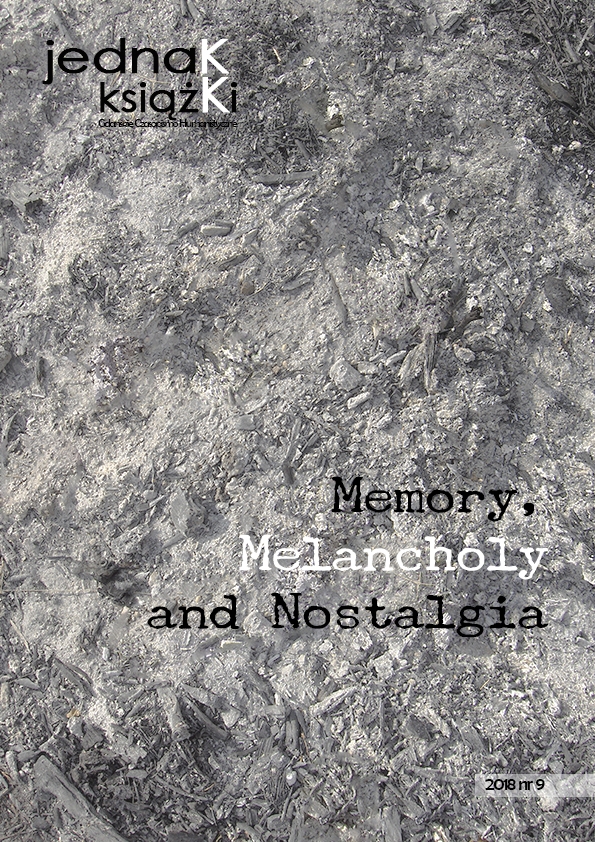Writing (in) melancholy. Loss and remembrance in the works of two contemporary Hindi writers
DOI:
https://doi.org/10.26881/jk.2018.9.05Słowa kluczowe:
melancholy, loss, mourning, Teij Grover, Udayan Vajpeyi, Hindi literatureAbstrakt
The paper aims at analysing the question of melancholy and memory in contemporary Hindi literature. The author selected works by two Hindi writers (T. Grover and U. Vajpeyi), who represent similar approach towards literature and use similar means of expression. The two main motifs characteristic for their writing – love (pyār) and loss (a-bhāv) – are closely related to the creative process: the loved one is the lost object, the one subjugated to melancholy, who can be remembered through writing. In the light of A. Świeściak’s idea of “melancholic subject” and S. Bahun’s concept of “performing melancholia”, the author discusses ways in which both the writers construct their literary world, inhabit it with loved/absent objects (beloved, father), and mourn their loss. The subject in their writing is both fictional and biographical, so the loss relates to literary as well as real events, becomes multidimensional. In Grover’s Blue, the subject’s separation with the beloved leads her to realise the loss of her father in childhood, and thus unveils the mourning and melancholy (symbolically represented by blue/Blue). U. Vajpeyi’s poems create a space for meeting his lost love, for weeping and remembrance, for exchanging letters (and writing). The results of the present study show that melancholy – as a consequence of loss, mourning, and remembering - becomes a creative force, inducing the author (narrator, subject) to write.
Downloads
Bibliografia
Bahun Sanja. 2014. Modernism and Melancholia: Writing as Countermourning. New York: Oxford University Press.
Blanchot Maurice. 1989. Orpheus’s Gaze, 171-176. In: Blanchot Maurice. The Space of Literature. Smock Ann, trans. Lincoln-London: University of Nebraska Press.
Blanchot Maurice. 2003. The Infinite Conversation. Hanson Susan, trans. Minneapolis and London: University of Minnesota Press.
Choińska Bogna. 2011. „‘Le mur du langage’ –samotność według Jacques’a Lacana (inność, porozumienie, miłość).” Przestrzenie Teorii 15: 141-153.
Freud Sigmund. 2008. Mourning and Melancholia, 73-94. In: Freud Sigmund. The Future of an Illusion. Underwood J.A, Whiteside Shawn, trans. London: Penguin Books.
Fromm Erich. 2008. The Art Of Love. New York-London: Continuum.
Grovar Tejī. 1999. Nīlā. Naī Dillī: Vānī Prakāśan.
Grover Teji. 2000. “Neela”. Nayak Meena Arora, trans.Hindi: Language, Discourse, Writing (1/1): 54-75.
Junik-Łuniewska Kamila. 2015. Literatura jako proces pisania. Analiza „Błękitu” Tedźi Grower w świetle przemian współczesnej prozy hindi. Kraków: Księgarnia Akademicka.
Kakar Sudhir, Ross John M. 1999. Tales of Sex, Love and Danger. New Delhi: Oxford University Press.
Kristeva Julia. 1992. Black Sun. Depression and Melancholia, New York: Columbia University Press.
Mokrosiński Łukasz. 2009. „Realne urzeczywistnione – słowo o depresji i melancholii.” Online: http://sinthome.pl/pic/StronaPL/insomnia/LM_melancholia.pdf. Accessed October 22, 2016.
Neyman Elżbieta. 2001. A słowo ciałem się stało, 42-64. In: Nasiłowska Anna ed. Ciało i tekst. Feminizm w literaturoznawstwie –antologia szkiców, Warszawa: Instytut Badań Literackich.
Świeściak Alina. 2010. Melancholia w poezji polskiej po 1989 roku. Kraków: Universitas.
VājpeyīUdayan. 1995. Kuch vāky. NaīDillī: VānīPrakāśan.
Werner Wiktor. 2008. Miłość jako metafora, 67-76. In: Płonka-Syroka Bożena, Radziszewska Janina, Szlagowska Aleksandra, ed. Antropologia miłości tom 1. Miłość kobiety. Wrocław: Oficyna Wydawnicza Arboretum.

 Uniwersyteckie Czasopisma Naukowe
Uniwersyteckie Czasopisma Naukowe





